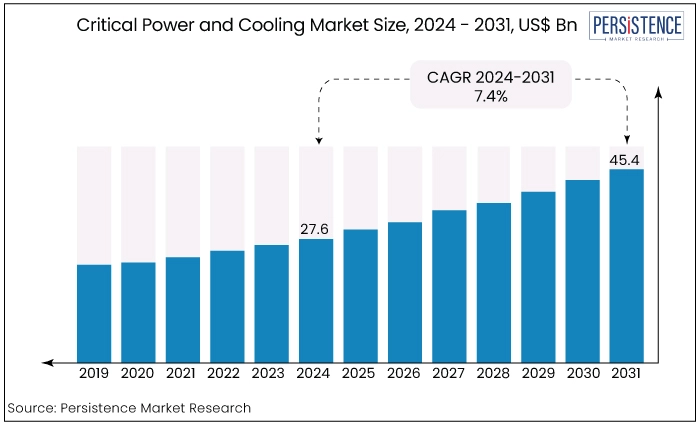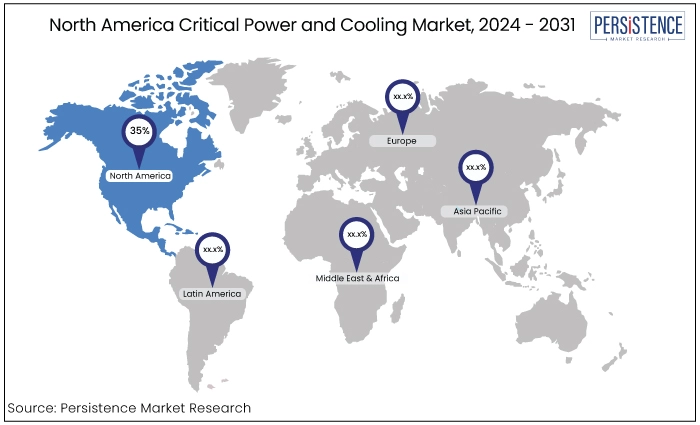Industry: Energy & Utilities
Published Date: September-2024
Format: PPT*, PDF, EXCEL
Delivery Timelines: Contact Sales
Number of Pages: 169
Report ID: PMRREP34762
The critical power and cooling market is estimated to increase from US$27.6 Bn in 2024 to US$45.4 Bn by 2031. The market is projected to record a CAGR of 7.4% during the forecast period from 2024 to 2031. Increased urbanization and industrialization in leading emerging economies has a significant share in the overall growth of the critical power and cooling market. With the latest innovations in data center management and the advent of green building practices, the market is witnessing a surge in demand from across the globe.

Key Highlights of the Market
|
Market Attributes |
Key Insights |
|
Critical Power and Cooling Market Size (2024E) |
US$27.6 Bn |
|
Projected Market Value (2031F) |
US$45.4 Bn |
|
Global Market Growth Rate (CAGR 2024 to 2031) |
7.4% |
|
Historical Market Growth Rate (CAGR 2019 to 2023) |
6.7% |
|
Region |
Market Share in 2024 |
|
North America |
35% |
North America critical power and cooling market is fueled by strong economic growth and technological advancements with the United States at the forefront. Significant investments in data centers and telecommunications infrastructure drive this expansion.
The rise of edge computing, which brings data processing closer to the end-users, requires robust critical power and cooling solutions. North America’s adoption of edge computing drives demand for localized power and cooling systems, further boosting market opportunities.
In June 2022, Schneider Electric, a frontrunner in energy management and automation, carried out three independent research studies to evaluate sustainability maturity in the IT and data center sectors, with an emphasis on reaching net-zero IT operations. Recent findings from these studies, presented at a press conference in Delhi, highlighted a significant gap in sustainability efforts.

Market growth in Asia Pacific is propelled by rapid industrialization and urbanization with China, India, and Japan leading in investments in data centers, telecommunications, and smart city infrastructure. For example, Blue Star Ltd, based in India, launched affordable split air conditioners that emphasize high quality and durability.
The company focus on energy-efficient technologies and advanced cooling systems aims to meet the growing demand for reliable cooling in various sectors, enhancing operational efficiency and sustainability in the region's rapidly evolving market.
Europe's critical power and cooling market is experiencing significant growth driven by its leadership in automotive manufacturing and IT services. The increasing adoption of renewable energy and smart grid technologies emphasizes sustainability and operational resilience.
Innovations in data center management and green building practices further enhance the region's position as a leader in critical power and cooling solutions across various industries. This focus on advanced technologies is crucial for meeting the demands of a rapidly evolving market landscape.
|
Category |
Market Share in 2024 |
|
End Use - Industrial |
40% |
The industrial segment is expected to account for 40% share in the market driven by the IT and telecom sectors' reliance on uninterrupted power and efficient cooling for data centers. The surge in mobile devices and IoT further amplifies the need for reliable infrastructure prompting investments in advanced power backups and cooling technologies.
Innovations in power and cooling technologies, such as energy-efficient systems, smart grid solutions, and advanced cooling techniques, have helped industrial players stay ahead. These advancements allow for better management of energy consumption, reduced operational costs, and enhanced system reliability.
The critical power and cooling market is an essential segment of the global infrastructure landscape. Critical power and cooling refer to systems and solutions that ensure uninterrupted power supply and optimal temperature management for sensitive equipment in industries such as data centers, telecommunications, and healthcare. This market encompasses a range of products and services.
The rise in power shortages globally has heightened the need for reliable backup power systems. As urbanization and industrialization accelerate, businesses are increasingly investing in critical power solutions to protect their operations from grid power fluctuations and outages.
Additionally, critical power and cooling market companies are increasingly adopting eco-friendly solutions, such as energy-efficient cooling systems and renewable energy sources, to reduce their carbon footprint.
Innovations in power and cooling technologies are driving market growth. The integration of smart technologies and IoT (Internet of Things) in power management systems is enhancing efficiency and reliability.
Further, the proliferation of data centers, driven by the digital transformation and the rise of cloud computing, is a significant factor contributing to market growth. All these critical power and cooling market trends are expected to propel the industry growth.
The critical power and cooling market analysis has demonstrated significant growth over the past few years. The market experienced a CAGR of 6.7% during the period from 2019 to 2023. Market growth can be attributed to several factors including increasing power shortages, rapid urbanization, and the rising demand for backup power solutions to safeguard critical operations from grid fluctuations.
The market is projected to continue its upward trajectory, reaching US$ 27.6 Bn in 2024 and an impressive US$ 45.4 Bn by 2031. This forecast indicates a robust CAGR of 7.4% from 2024 to 2031, driven by ongoing technological advancements and the increasing reliance on data centers and other critical infrastructure.
The integration of advanced technologies, such as IoT and AI, into power management systems is expected to enhance operational efficiency and reliability. With growing environmental concerns, there is a strong push towards sustainable practices within the industry. Rapid industrialization and increasing energy demands in countries like China and India are expected to further boost the critical power and cooling market share.
Increasing Demand for Data Centers
The rapid growth of digitalization and cloud computing has led to a significant rise in the number of data centers. These facilities require robust critical power and cooling solutions to ensure operational efficiency and reliability.
As businesses increasingly rely on data-driven technologies, the demand for effective power management and cooling systems will continue to surge driving critical power and cooling market growth. This trend is further driven by the need for enhanced cooling efficiency to manage the heat generated by high-density computing environments.
Ongoing Urbanization and Industrialization
The ongoing urbanization and industrialization across the globe are key contributors to the market growth. As cities expand and industries evolve, the demand for reliable power supply and cooling systems becomes critical. This is particularly evident in sectors such as healthcare, finance, and manufacturing, where uninterrupted power is essential for operational continuity.
The increasing number of facilities in urban areas necessitates advanced power and cooling solutions to mitigate risks associated with power outages and ensure efficient operations, ultimately driving critical power and cooling market demand.
Need for Backup Power Solutions
With the rising frequency of power outages and grid fluctuations, there is an escalating need for backup power solutions across various sectors. Organizations are investing in critical power systems to protect their equipment and maintain operational integrity during power disruptions. The market trend is particularly pronounced in industries such as telecommunications, healthcare, and finance, where downtime can lead to significant losses.
The growing awareness of the importance of reliable power supply is driving investments in uninterruptible power supplies (UPS) and other backup systems further propelling market growth.
High Investment Costs
One of the primary challenges is the substantial initial investment required for advanced power and cooling systems hindering the critical power and cooling market sales.
Organizations often struggle to allocate significant capital for these solutions, especially small and medium-sized enterprises. The high costs associated with purchasing, installing, and maintaining critical power infrastructure can deter potential buyers, limiting market growth. Additionally, the financial burden can further impede investment decisions, slowing the overall market expansion.
Environmental and Health Risks
The critical power and cooling sector faces scrutiny due to environmental and health concerns associated with traditional cooling methods, such as those using refrigerants that can contribute to global warming.
Regulatory pressures aimed at reducing carbon emissions and promoting sustainable practices are increasing. The need to balance performance with environmental responsibility can hinder critical power and cooling market revenue, as organizations may be reluctant to invest in systems that do not align with sustainability goals.
Integration of Renewable Energy Sources
As the global focus shifts towards sustainability, the integration of renewable energy sources presents a significant opportunity for the market. Organizations are increasingly adopting solar, wind, and other renewable energies to power their critical infrastructure. This shift not only reduces reliance on traditional power grids but also lowers operational costs in the long run.
By developing innovative power and cooling solutions that synergize with renewable technologies, companies can meet both efficiency and sustainability goals, driving market growth and enhancing their competitive edge.
Advancements in Energy-Efficient Technologies
The growing emphasis on energy efficiency offers substantial critical power and cooling market opportunities for innovations. Companies can invest in the development of advanced cooling solutions, such as liquid cooling and immersion cooling technologies, which significantly reduce energy consumption and improve overall performance. The integration of smart technologies, including AI and IoT, can optimize power management and cooling processes, leading to substantial cost savings.
The critical power and cooling market is witnessing rapid growth, as indicated by the market report, reflecting its dynamic character. Companies in the industry are launching new products and integrating innovative technologies to create new opportunities.
Key players in the market are adopting key business strategies to broaden their product ranges, increase market shares across different regions, invest in research and development, and optimize supply chains to enhance overall market value.
Recent Developments in the Critical Power and Cooling Market
|
Attributes |
Details |
|
Forecast Period |
2024 to 2031 |
|
Historical Data Available for |
2019 to 2023 |
|
Market Analysis |
US$ Billion for Value |
|
Key Regions Covered |
|
|
Key Market Segments Covered |
|
|
Key Companies Profiled |
|
|
Report Coverage |
|
|
Customization & Pricing |
Available upon request |
By Type
By End Use
By Region
To know more about delivery timeline for this report Contact Sales

The market is predicted to rise from US$ 27.6 Bn in 2024 to US$ 45.4 Bn by 2031.
A few of the leading industry players operating in the market are ABB, Asetek A/S, and Cyber Power Systems.
The industrial segment is expected to account for 40% share in the market.
The critical power industry includes data centers, hospitals, schools, and offices. It ensures that systems remain operational during power cuts, fluctuations, brownouts.
The market is estimated to record a CAGR of 7.4% during the forecast period from 2024 to 2031.